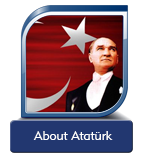|
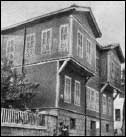 |
Mustafa Kemal Atatürk was born in a pink three-storey house in the district of Kocakasım on İslahiye Street in Salonika. His father was Sir Ali Rıza; his mother was Mrs. Zübeyde. His grandfather on his father’s side was Sir Hafız Ahmet from the Kocacık Yoruk Tribes, who immigrated and settled in Macedonia from Konya and Aydın in the XIV-XV centuries. His mother was the daughter of an old Turkish family who settled in Langaza, near Salonika. Sir Ali Rıza, who was a militia officer, pious foundation clerk, and lumber trader, married Mrs. Zübeyde in 1871. Four of the five siblings of Atatürk died at early ages, only Makbule (Atadan) lived till 1956. |
When Mustafa got to school age, he started his education at Sir Hafız Mehmet’s local school. Then he changed his school to Şemsi Efendi School at the insistence of his father. During this time he lost his father, in 1893. After staying with his uncle in the Rapla Farmhouse for a while, he went back to Salonika and passed through school. Later, he entered military school. In this school, his math teacher Sir Mustafa added “Kemal” to his name. In the years of 1896-1899, he finished Monastry Military High School, and started his education at the Military Academy. He graduated with a lieutenant degree in 1902. He attended the War Academy on 11 October, 1905, and he finished the Academy with a senior grade degree. |
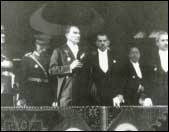
|
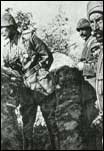 |
Between the years of 1905 and 1907, the Fifth Army carried out duty under him. In 1907, he became Lieutenant Commander. He was appointed to the Third Army in Monastery. On 19 April, 1909, he worked as Chief of Staff in the Action Army, which entered İstanbul. In 1910, he was sent to France. He joined the Monoeuvers of Picardie. In 1911, he started working under the Turkish General Staff in İstanbul. In 1911, in the war which started with the attack of Italians to Tripoli, Mustafa Kemal took charge with a group of his friends in the region of Tobruk and Derne. On 22 December, 1911, he won the Tobruk War against the Italians. On 6 March, 1912, he was inducted as Commander of Derne. |
In October 1912, when the Balkan War started, Mustafa Kemal crusaded with the troops in Gallipoli and Bolayır. In the retrieval of Dimetoka and Edirne, he made a significant contribution. In 1913, he was appointed to Attache Military. In the meantime with this duty, he was promoted to Lieutenant Colonel in 1914. Meanwhile, First World War started and The Ottoman Empire was obliged to go to war. Mustafa Kemal was charged with organizing the 19th Division in Tekirdağ.
In the First World War, which started in 1914, when British and French Navies suffered heavy losses on the attempt to cross the Gallipoli Strait, they decided to land troops on the Gallipoli Peninsula. |
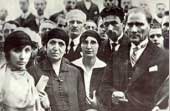
|

|
The 19th Division, which was commanded by Mustafa Kemal, stopped the opposing forces in Conkbayırı who reached Arıburnu. On this achievement, Mustafa Kemal was promoted to Colonel. On 6-7 August, 1915, the British began to attack again. Mustafa Kemal, who was the commander of the Group of Suvla, won the Suvla Victory on 9-10 August. On 17 August, the Victory of Kireçtepe and the 2nd Anafartalar Victory on 21 August. The Suvla Victories followed these victories. The Turkish Nation, who gave up about 253.000 martyrs in the Battles of Gallipoli, defended its honor against the Entente Powers. Mustafa Kemal’s command, which was “I do not command you to attack, I command you to die,” changed their destiny. |
After the Battles of Gallipoli, Mustafa Kemal took charge in Adrianopolis and Diyarbakır. On 1 April, 1916, he was promoted to Major Generalship. He provided the retrieval of Muş and Bitlis, fighting with Russian forces. After short-term duties in Damascus and Aleppo, he came back to Istanbul in 1917. He went to Germany with Sir Velihat Vahidettin and he examined the frontline. After this trip, he fell sick. He was treated in Vienna and Karisbad.
On 15 August, 1918, he came back to Aleppo as the Seventh Army Commander. On this front, he fought victorious defensive wars against British forces. |
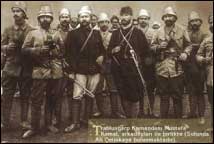
|

|
A day after signing the Mondros Armistice Agreement, Mustafa Kemal was appointed to the command of the Thunder Groups on 31 October, 1918. Upon the rescission of this army, on 13 November, 1918, he came back to İstanbul and took office in the Ministry of War. After the Mondros Armistice Agreement, when the Entente States occupied Ottoman Armies, Mustafa Kemal transferred to Samsun as Ninth Army Inspector on 19 May, 1919. On 22 June, 1919, with a letter that he circulated, he declared that “The independence of the nation will be saved by the determination and consistency of the nation,” and he called the Sivas Congress to a meeting. |
Between the dates of 23 July and 7 August, 1919, he convened the Erzurum Congress. Between the dates of 4 and11 September, 1919, he convened the Sivas Congress for determining the itinerary for the liberation of the nation. On 27 December, 1919, he was welcomed excitedly in Ankara. With the opening of Grand National Assembly of Turkey on 23 April, 1920, an important step for the establishment of the Turkish Republic was taken. Mustafa Kemal was elected as President of the Assembly and Prime Minister. The Grand National Assembly of Turkey successfully adopted and applied the necessary legislation for ending the War of Independence. The Turkish War of Independence had started with the firing of the first bullet at the enemy during the occupation of İzmir by the Greeks, which was initially a war made with militia forces called Turkish Revolutionaries against the victorious powers of the First World War who shared Ottoman Empire among themselves. By signing the Treaty of Sevres, the Grand National Assembly of Turkey established a regular army, and ended the war in victory by ensuring the integrity of Turkish Revolutionaries and the army. |
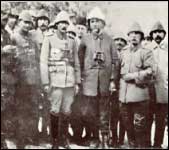
|

|
On 19 September 1921, after the Sakarya Victory, the Grand National Assembşy of Turkey gave Mustafa Kemal the degree of Ghazi and Marshall. The War of Independence ended up with Treaty of Lousanne, which was signed on 24 July, 1923. Thus, there were no obstacles for the foundation of the new Turkish state which was based on national unity on Turkish land that was shattered and left with only a five or six city-sized nation to the Turkish people. The foundation of the Turkish Republic was heralded with the opening of the Grand National Assembly of Turkey on 23 April, 1920 in Ankara. The Parliament’s successful management of the War of Independence expedited the foundation of the Turkish Government. |
On 1 November, 1922, the Caliphate and Sultanate diverged and the Sultanate was abolished. Thus, government’s connections with the Ottoman Empire were cut. On 13 October, 1923, the Republican regime was accepted and Atatürk was elected as the first president. On 30 October, 1923, the first government of the Republic was formed by İsmet İnönü. The Turkish Republic started to rise on the basis of “Peace at home, peace in the world” and “Sovereignty rests unconditionally with the nation.” Atatürk was elected as Turkish Parliamentary Speaker on 24 April, 1920 and on 13 August, 1923. On 29 October, 1923, the Republic was declared and Atatürk was elected the first President of the Republic. In 1927, 1931, 1935, the National Assembly of Turkey elected Atatürk as President of the Republic again.
On 15-20 October, 1927, he read his grand speech which was about War of Independence and the foundation of the Republic, and on 29 October, 1933, he read his Tenth Year Speech. |
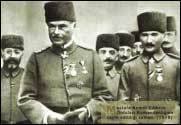
|

|
Atatürk lived simply in his private life. On 29 January, 1923, he married Mrs. Latife. They went to many nationwide tours together. This marriage lasted until 5 August, 1925. Atatürk, who was very fond of children, adopted girls called Afet (İnan), Sabiha (Gökçen), Fikriye, Ülkü, Nebile, Rukiye, Zehra, and a shepherd named Mustafa. He took children named Abdurrahim and İhsan under his protection. |
In 1937, he donated his farms to the National Treasury and a part of his real estate to the Ankara and Bursa Municipalities. He reserved a share from his heritage for his sister, adopted children and the Turkish Language Society and the Turkish Historical Society. He was enchanted by reading, listening to music, dancing, riding, and swimming. He was caught up in the Zeybek dance, wrestling, and Rumelia songs. He enjoyed playing backgammon and billiards. He put a premium on his horse named Sakarya and his dog named Fox. He established a rich library. He invited statesmen, scientists, and artists for dinner and they discussed the problems of the nation. He was attentive to being dressed cleanly and carefully. He was attentive to nature. He often went to the Atatürk Forest Farm and he worked there himself. |
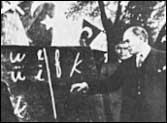
|
On 10 November 1938, at 9:05, he abandoned this life in Dolmabahçe Palace in İstanbul as he could not recover from cirrhosis. He was laid to rest with a funeral ceremony on 21 November, 1938 in the Ankara Ethnography Museum, which was his temporary resting place. When the Anıtkabir was completed, his body was laid to rest with a magnificent funeral ceremony on 10 November, 1953. |
|
|


